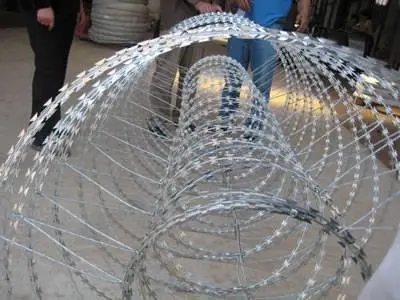Detailed Explanation of Barbed Wire Specifications and Its Application Fields

Specification Details of Barbed Wire:
Materials:
●Low - carbon Steel Wire: This is the most commonly used raw material for barbed wire. It has certain strength and toughness, which can meet the protective requirements of barbed wire.
●Stainless Steel Wire: It has good corrosion resistance and is suitable for places that are exposed to harsh environments such as humidity, acid and alkali for a long time, like seaside areas, chemical plants, etc.
Wire Diameter: The wire diameter of barbed wire refers to the diameter of the steel wire that makes up the barbed wire. Common wire diameters include 1.8mm, 2.0mm, 2.5mm, 2.8mm, etc. Generally, the thicker the wire diameter, the higher the strength of the barbed wire and the better the protective performance.
Barb Spacing: Barb spacing refers to the distance between two adjacent barbs on the barbed wire. Common barb spacings are 3 inches (about 76.2mm), 4 inches (about 101.6mm), 5 inches (about 127mm), 6 inches (about 152.4mm), etc. The smaller the barb spacing, the higher the density of barbs, and the better the protective effect, but the cost will also increase accordingly.
Barb Length: The length of the barb is also an important specification parameter of barbed wire. Common barb lengths are 10mm, 12mm, 15mm, 22mm, etc. The longer the barb, the greater the deterrence to intruders and the better the protective performance.
Twisting and Braid - making Methods:
●Positive Twisting: Twist two or more iron wires into a double - stranded wire rope, and then wind the barbed wire around the double - stranded wire.
●Reverse Twisting: First wind the barbed wire around the main wire (a single iron wire), and then add another iron wire to twist and braid it into a double - stranded barbed wire.
●Positive and Reverse Twisting: Twist the barbed wire in the opposite direction from the place where the barbed wire is wound around the main wire, not in the same direction.
Application Details of Barbed Wire:
Application Scenarios:
●Boundary Protection: It is used for the boundary protection of farms, ranches, orchards, etc., to prevent livestock, wild animals, etc. from entering or running out. It is also often used for the protection of important areas such as national borders and military restricted zones.
●Building Protection: Installed on the fences, railings, windows, etc. of buildings to play a role in anti - theft and anti - climbing, such as in places with high - security requirements like banks, prisons, and banknote printing factories.
●Road Protection: As an isolation and protection net on both sides of road facilities such as highways, railways, and bridges, it prevents pedestrians and animals from entering the road and ensures driving safety.
Installation Methods:
●Column Installation: First install the columns, and then fix the barbed wire to the columns. The spacing of the columns is determined according to the specifications of the barbed wire and the protection requirements, generally between 2 - 3 meters. The columns can be metal pipes, concrete columns, etc., and their firmness and stability need to be ensured.
●Direct Fixing: In some special occasions, such as brick walls and concrete walls, drill holes directly on the wall surface, and then use expansion bolts or other fasteners to fix the barbed wire to the wall.

Safety Precautions:
●Set Warning Signs: Set obvious warning signs around the area where the barbed wire is installed to remind people to pay attention to safety and avoid accidentally touching the barbed wire and getting injured.
●Comply with Laws and Regulations: Before installing the barbed wire, understand the local laws, regulations, and relevant provisions to ensure the legality of the installation behavior. For example, in some urban residential areas, there may be certain restrictions on the installation of barbed wire.
●Regular Inspection and Maintenance: Regularly inspect the fixing condition of the barbed wire and the integrity of the barbs, etc., discover and handle problems in a timely manner, and ensure that the protective performance of the barbed wire is always in good condition.










